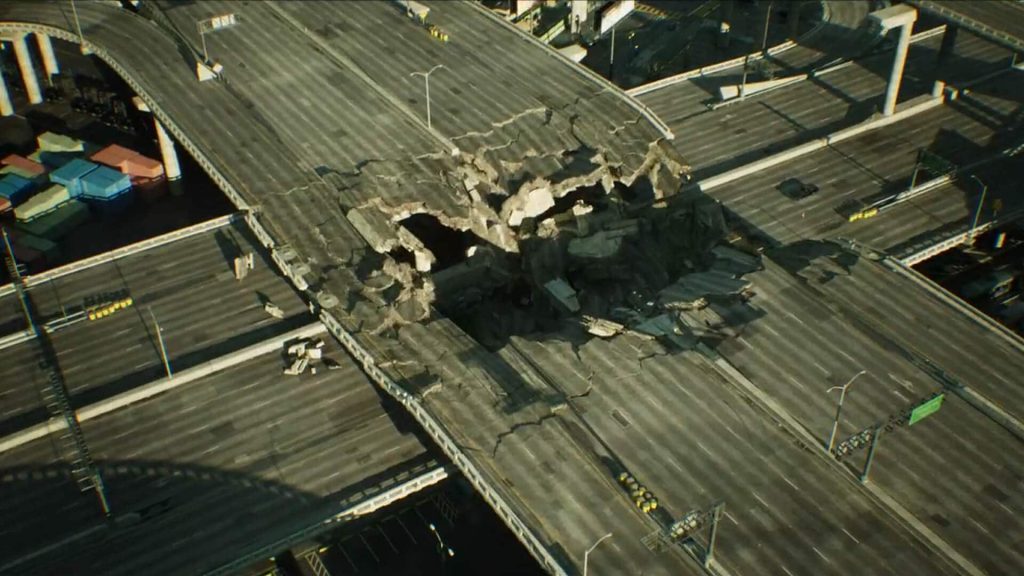The UE5 Chaos Physics and Destruction System is Unreal Engine 5’s next-generation physics engine, designed to simulate real-time physical interactions and dynamic destruction with high accuracy. It replaces the older PhysX system and introduces a more scalable, realistic, and developer-friendly solution for creating interactive environments in games, cinematics, and virtual production.
Whether you’re breaking a wooden crate, collapsing a skyscraper, or triggering an explosion that sends debris flying, Chaos delivers physically accurate results based on material properties, force, mass, and collision behavior.

Key Features of the UE5 Chaos Physics & Destruction System
1. Real-Time Physics Simulation
Chaos enables high-performance, real-time physics simulation so objects can move, collide, and react just like they do in the real world.
Core Simulation Features:
- Collision Detection – Accurate detection between objects of any size or shape
- Rigid Body Dynamics – Realistic movement for solid objects like vehicles, props, debris, etc.
- Physics-based gameplay – Perfect for puzzles, falling structures, kinetic interactions, etc.
2. UE5 Dynamic Destruction System
Chaos offers fully procedural destruction, meaning objects don’t just disappear — they break apart logically based on impact, stress, and material type.
Destruction Tools Include:
- Fracture Tools – Pre-fracture any mesh into realistic chunks
- Multiple destruction types – Rigid, geometry collections, cloth tearing, glass shattering, etc.
- Damage Thresholds & Propagation – One impact can trigger chain-reaction destruction
Example: A collapsing wall can realistically bring down adjacent structures.
3. UE5 Chaos Fields & Physics Modifiers
For more advanced behavior, developers can use:
- Chaos Fields – Forces like explosions, shockwaves, gravity influencers, directional pushes
- Modifiers – Change object mass, friction, elasticity, and other physics properties at runtime
This allows for complete control over both micro-physics (small object behavior) and macro-physics (large-scale destruction events).
4. Niagara VFX Integration
Chaos works seamlessly with Niagara, Unreal Engine’s particle system.
✅ Generate debris, sparks, smoke, and dust in sync with destruction
✅ Use real-time physics to drive particle movement
✅ Create cinematic-quality explosions, crumbling structures, particle-based fire, etc.
Example: When glass shatters, Niagara can auto-spawn dust shards and falling particles.
5. Designed for Scalability & Performance
Epic built Chaos for both AAA-quality visuals and runtime optimization.
- Level of Detail (LOD) for destruction systems
- Asynchronous physics to prevent FPS drops
- Efficient performance even in large-scale destruction scenes
Chaos is optimized for PC, console, and next-gen platforms like Unreal Engine’s Nanite & Lumen rendering pipelines.
How to Enable Chaos Physics in UE5
- Open your UE5 project
- Go to Edit → Plugins
- Search for “Chaos”
- Enable:
- ✅ Chaos Physics
- ✅ Chaos Destruction
- Restart the engine
Creating Destructible Objects in UE5
- Convert a Static Mesh to a Geometry Collection
- Use Fracture Tools to split it into chunks
- Define:
- Material (wood, stone, metal, glass, etc.)
- Fracture pattern (uniform, clustered, custom)
- Damage properties (force needed to break)
- Simulate destruction in the viewport using explosions, impacts, or physics fields.
Why UE5 Chaos Physics Matters for Game Development
✔ Realistic, immersive environments
Players interact with worlds that truly react — explosions, collapsing buildings, breakable cover, destructible terrain, etc.
✔ New gameplay mechanics
Chaos makes destruction part of level design, not just visual effects.
✔ Improved visual storytelling
Destruction can support narrative moments — crashes, collapsing towers, battle aftermath, natural disasters, etc.
📌 FAQ
1. What is Chaos Physics in Unreal Engine 5?
Chaos Physics is UE5’s built-in real-time physics engine used to simulate motion, collisions, and destruction with high fidelity.
2. What replaced PhysX in Unreal Engine?
PhysX was removed in UE5 and replaced by the Chaos Physics and Destruction System developed by Epic Games.
3. Can Chaos simulate large-scale destruction like buildings collapsing?
Yes — Chaos supports both small-scale and large-scale destruction with fracture simulation, force propagation, and debris generation.
4. Do I need plugins to use Chaos in UE5?
Yes, you must enable the Chaos Physics and Chaos Destruction plugins in the UE5 project settings.
5. Does Chaos work with Niagara VFX?
Yes. Chaos and Niagara are fully integrated, enabling real-time particle effects like debris, smoke, sparks, and dust.
6. Can Chaos Physics be used in film/virtual production, not just games?
Absolutely — Chaos is now widely used in virtual production, simulation, previs, and cinematic pipelines.